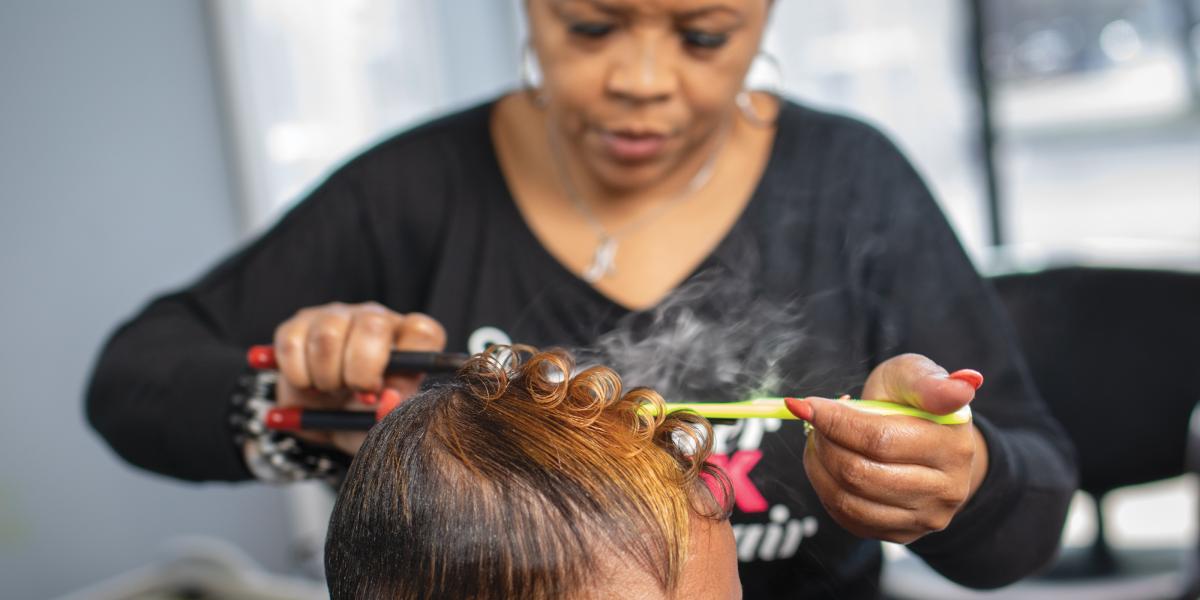Beauty’s Byproducts
Dyes, relaxers, and conditioners give salon clients the styles they want—and leave salon workers with a potentially dangerous chemical burden.
Late in the week, Tré Shadez Hair Studio in Capitol Heights, Maryland, brims with style and energy. Owner Katrina Randolph and seven other stylists juggle eight to 10 clients a day, straightening hair, texturizing, dyeing, curling. Odors from chemical relaxers, hair spray, bleaches, and conditioners blend in a pungent swirl you can feel in your lungs and eyes. Blow-dryers whir behind animated conversations, creating an artificial breeze that does little to dilute the chemical smell. Steam wisps up from hair shaped by straightening or curling irons.
Randolph, who founded the salon with her husband 22 years ago, is a member of Health Advocates In-Reach and Research (HAIR), a program that engages barbershops and beauty salons in Prince George’s County, Montgomery County, and Baltimore City to educate their clients about everything from blood pressure and cancer screenings to COVID-19 vaccinations. Randolph herself was the lead instructor for the White House COVID-19 mitigation initiative Shots@TheShop and hosted vaccination events at Tré Shadez.
Through HAIR, Randolph was recruited for a study of chemical exposures from hair salon products and processes. The study, led by Lesliam Quirós-Alcalá, PhD, MSc, an assistant professor in Environmental Health and Engineering, measured the levels of certain chemicals in the air of the salon and in the stylists’ urine.
Quirós-Alcalá studies chemical exposures that may harm health, focusing on salon workers and other groups that may be particularly vulnerable to those exposures.
Existing research on exposures to chemicals in beauty products has concentrated on the threat to consumers, not salon workers, Quirós-Alcalá says. “We’re ignoring this population who is even more highly exposed, so we have to protect them as well,” she says.
Many hair products—relaxers, hairsprays, gels, and more—contain phthalates, endocrine-disrupting components associated with health problems like breast cancer, fertility problems, preterm births, and pregnancy complications. Other products, such as hair dyes and hair bonding glue, include volatile organic compounds (VOCs) that with chronic exposure may increase the risk of birth defects, respiratory illnesses, neurocognitive problems, and cancer. Hairstyling processes that involve heat generate both VOCs and particulate matter that are linked to asthma, skin conditions, cancer, and other problems.
Despite the potential dangers, no federal law requires manufacturers to list the ingredients in professional-use products.
“It’s not as simple as just looking at the label and saying, ‘Oh, I shouldn’t be using this,’” Quirós-Alcalá says. A list of such chemicals would be insufficient anyway because applying heat and mixing products can create new chemicals with their own potentially harmful properties.

Duration and timing of exposure further complicate the work of studying chemicals’ health effects. The damage caused by exposure to a certain chemical over time—or during a critical window of susceptibility—may not be evident for many years. It might even show up in offspring rather than the person who was exposed.
Quirós-Alcalá is interested in both how exposures occur and who is being exposed to inform interventions to mitigate potentially harmful exposures. In general, women have greater exposure to these chemicals because they use more personal care products than men do. Women of color, who use more types and greater quantities of hair care products, may be even more highly exposed.
Quirós-Alcalá believes that environmental justice should be embedded in exposure science, so she focused her interest specifically on stylists who serve women of color. Not only do these stylists typically work with potentially more dangerous products and processes, but the salons where they work are often located in neighborhoods that may already have elevated levels of environmental contaminants, potentially increasing their total exposure to toxic chemicals.
Thanks to recruitment efforts by HAIR and another crucial community partner, the nonprofit Centro de Apoyo Familiar (CAF), 23 hair stylists working in three Black salons and three Dominican salons participated in a pilot study to measure these exposures. In the study, Quirós-Alcalá and her research team analyzed urine samples of salon workers at the end of their shifts to characterize biomarker concentrations of phthalates and VOCs. The research team also conducted air sampling to capture the contaminants that salon workers breathe during an 8-hour shift.
In a paper published last year in Environmental Science & Technology, the researchers found that salon workers, on average, had concentrations of some VOCs that were more than four times higher than those in the general population of U.S. women. On average, they had a biomarker concentration of monoethyl phthalate, or MEP—which is associated with reproductive problems—10 times higher than a comparison group of office workers. Stylists who provide chemical-based services such as chemical straightening, permanent hair color, and Brazilian blowouts had almost double the MEP concentrations of those who did not.
The results from the pilot study make Quirós-Alcalá want to dig deeper. She is pursuing a grant to conduct a bigger study, involving stylists from other racial and ethnic groups, to generate data that she hopes will lead to safer products and culturally relevant interventions to mitigate harmful exposures.
Meanwhile, Randolph wants stylists to have easy access to product-safety information.
“When [the researchers] came back and showed us that some of the products we were using showed up in our urine—and they could be potentially harmful—we began to change the type of products we use,” she says. “It’s definitely not covered in beauty school—they should add that into the teaching because it’s very important that we choose our products wisely.”
In addition to looking for safer products, Randolph convinced her landlord to give written confirmation that the air filters in the salon are replaced on the appropriate schedule. “We’re trying to turn our salon into a more eco-friendly salon,” she says.
